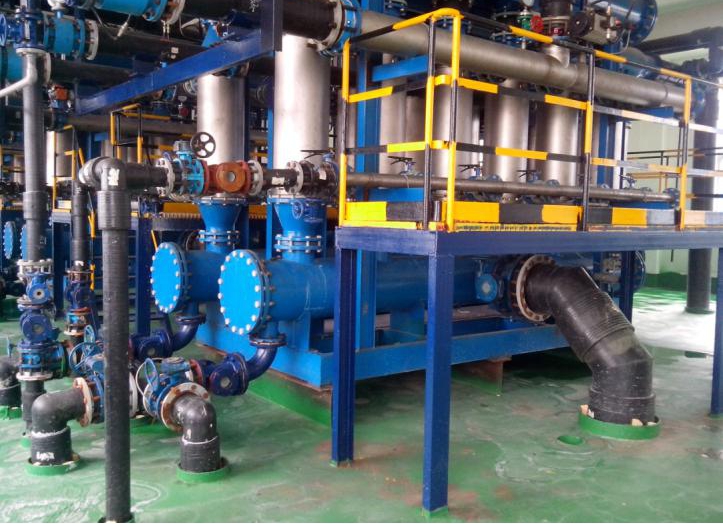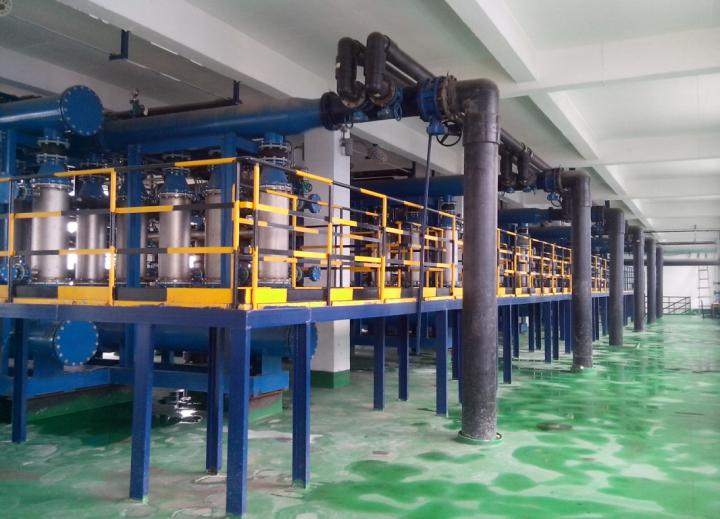The chlor-alkali industry produces chlorine and caustic soda by electrolyzing saturated brine, and the saturated brine must be refined and purified before it can be sent to the electrolytic cell. The quality of refined brine is related to the operating life and operating cost of the ion-exchange membrane electrolytic cell, which is also one of the key factors that determine the normal operation of the electrolysis process. Jiuwu Hi-Tech has researched on ceramic membrane brine refining technology since 2005, and successfully developed an inorganic membrane brine refining solution, obtaining a national patent for invention (patent number: ZL200610038868.6). The core of the inorganic membrane brine purification solution is the inorganic membrane separation coupled chemical reaction technology. The saturated crude brine formed from brine or raw salt through the salt dissolving section is sent to the reaction section, and sodium carbonate and sodium hydroxide are simultaneously added to the reaction tank for refining reaction. The calcium and magnesium ions in the crude brine are converted into calcium carbonate and magnesium hydroxide precipitation particles, and the cloudy brine is sent to the inorganic membrane filter to remove the suspended calcium and magnesium precipitation, and finally high-quality primary refined brine is obtained.
Process description:
After the light salt brine, process water and filtrate from outside the boundary enter the water distribution tank for mixing, they are fed into the salt dissolved pond by the salt dissolved tank for salt dissolving to feed pump, and the saturated crude brine flows into the reaction tank by itself, and sodium carbonate, sodium hydroxide and sodium hypochlorite are added to the brine inlet of the reaction tank. In the reaction tank, the calcium ions in the crude brine react with sodium carbonate to form calcium carbonate crystal precipitation after adding medicine; magnesium ions reacting with sodium hydroxide will form magnesium hydroxide colloidal precipitation, and sodium hypochlorite is used to eliminate organic matter and algae. After finishing the refining reaction, the crude brine flows into the intermediate tank by itself, and is sent to the inorganic ceramic membrane filtration device by the primary filter feed pump. The filtration unit adopts the internal circulation "cross-flow" filtration method, and the primary filtration circulating pump passes the crude brine feed liquid through the coarse filter and then sends it to the ceramic membrane filter for filtration, the filtered refined filter brine is discharged through the permeate clear liquid outlet of the ceramic membrane filter and enters the refined brine buffer tank, and is pumped through the refined filter brine to the ion membrane for secondary refining. The concentrated brine from the concentrated liquid outlet of the ceramic membrane filter is partly discharged into the salt sludge pond according to the proportion and concentration. Most of the concentrated brine is returned to the ceramic membrane filter through the primary filtration circulation pump for circulating filtration. The salt mud in the salt sludge pond is separated by the plate and frame filter and transported out of the area for discharge, and the filtrate is returned to the water distribution tank through the filtrate tank. After a long period of operation of the ceramic membrane filter, due to the pollution of the membrane surface, the flux will be changed and the filtration capacity will be decreased. Thus, the membrane surface needs to be chemically cleaned to regenerate it, so that the membrane flux is restored and the filtration capacity reaches the initial stage. status.


Site photos of brine filtration project of ceramic membrane equipment
After the ceramic membrane treatment, the SS in the brine can generally be reduced to less than 0.5 mg/L, and the ceramic membrane has high strength, basically not affected by acid, alkali and oxidants, and has excellent wear resistance in practical applications.
The technological process of ceramic membrane technology is greatly shortened, which greatly reduces the area and building area of the technical project. Due to poor resistance of organic polymer film to magnesium hydroxide and organic pollution, it is necessary to adopt a floating clarifying tank for pretreatment of filter brine. The ceramic membrane filtration technology reduces the process and equipment of pressurized dissolved gases, floating and clarification, and does not require the addition of corrosive chemicals such as ferric chloride, thereby reducing the corrosion hazards to equipment and pipelines. It can be seen that the inorganic ceramic membrane filtration system not only has a good treatment effect, but also can shorten the process flow, simplify the operation, reduce the operating cost, and promote the rapid development of the chlor-alkali industry.
Based on the high precision, high strength, corrosion resistance and pollution resistance of inorganic ceramic membrane, the inorganic membrane brine refining solution has wide applicability of raw materials, good water quality, short process flow, small footprint, long service life, simple operation and maintenance and other advantages. And this inorganic membrane brine refining solution won the China Invention Patent Excellence Award and the first prize of science and technology award of membrane industry association of China. After more than ten years of development, it has become the mainstream process covering nearly half of the domestic chlor-alkali production capacity and has been exported to India and Vietnam, South Africa and other countries and regions, winning unanimous praise from domestic and foreign customers.




 +86-25-58849045
+86-25-58849045
 +86-25-58749295
+86-25-58749295
 jiuwu@jiuwu.com
jiuwu@jiuwu.com
 No. 9 Park Road, Pukou District, Nanjing City (Sanqiao Factory)
No. 9 Park Road, Pukou District, Nanjing City (Sanqiao Factory) Call us on:
Call us on:  Email Us:
Email Us:  No. 9 Park Road, Pukou District, Nanjing City (Sanqiao Factory)
No. 9 Park Road, Pukou District, Nanjing City (Sanqiao Factory)

 English
English 한국어
한국어 français
français русский
русский Español
Español

